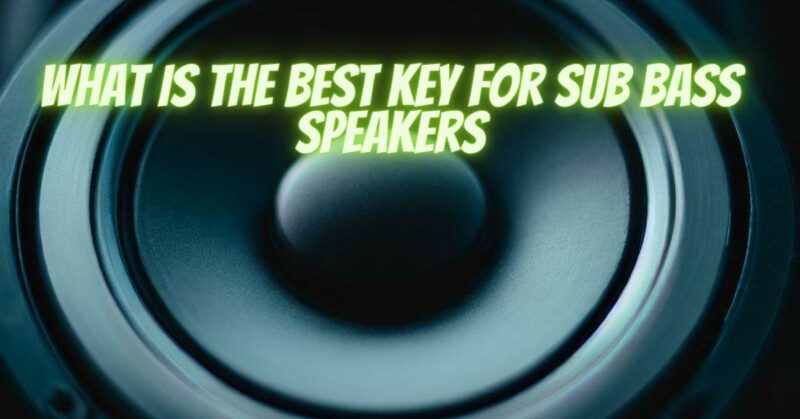Subwoofers are dedicated speakers designed to reproduce the deepest, most powerful bass frequencies in music and audio. When it comes to selecting the best key for sub bass speakers, the choice can significantly impact the performance and overall listening experience. In this article, we’ll delve into the factors influencing this decision and provide insights on choosing the ideal key for your subwoofer setup.
Understanding Sub Bass Speakers
Subwoofers are specialized speakers designed to handle low-frequency sound reproduction, particularly sub-bass frequencies. These frequencies typically range from 20 Hz to 60 Hz and are responsible for the rumbling, deep tones that you can feel as much as hear.
Factors Influencing the Best Key for Sub Bass Speakers
- Speaker Design and Specifications: Subwoofer speakers come in various designs, including sealed enclosures, ported enclosures, and horn-loaded enclosures, each with its unique frequency response characteristics. The best key for your subwoofer may depend on your specific speaker’s design and capabilities.
- Room Acoustics: The acoustics of the listening environment play a crucial role in determining the ideal key for sub bass speakers. Different room sizes and shapes can emphasize or attenuate certain frequencies. Conducting room measurements or using acoustic treatment can help optimize subwoofer placement and key selection.
- Musical Genre and Content: The type of music or audio content you plan to play through your subwoofer can influence the best key choice. For example:
- Electronic dance music (EDM) often features sub-bass frequencies in keys like C, D, or G, as they align with the resonance of typical subwoofers.
- Film soundtracks may contain sub-bass elements tailored to specific cinematic effects or emotional impact.
- Personal preferences may also dictate key choices based on the musical genres you enjoy most.
- Listening Goals: Consider your goals for the subwoofer when selecting the best key. Are you aiming for thunderous, room-shaking bass, or are you seeking a more balanced, musical listening experience? The key can affect the perceived power and character of the bass.
Experimentation and Testing
Choosing the best key for sub bass speakers often involves experimentation and testing. Here are some practical steps to help you make an informed decision:
- Trial and Error: Play a variety of music tracks with different sub-bass content through your subwoofer in different keys. Pay attention to how the bass frequencies are reproduced and how they interact with your room’s acoustics.
- Room Measurements: Use room measurement tools or software to assess the acoustic characteristics of your listening environment. These measurements can guide subwoofer placement and key selection.
- Speaker Capabilities: Familiarize yourself with the specifications and frequency response characteristics of your subwoofer speakers. Understanding their limitations and strengths can help you tailor your key choice.
- Listening Preferences: Trust your ears and personal preferences. Ultimately, the best key for your sub bass speakers should align with your musical tastes and listening habits.
- Seek Professional Advice: If you’re uncertain about the best key for your specific setup, consult with an audio professional or acoustician who can provide tailored guidance based on your equipment and room.
Selecting the best key for sub bass speakers is a dynamic and context-dependent process. It involves a balance between your audio equipment, room acoustics, musical content, and personal preferences. By experimenting, testing, and considering these factors, you can optimize your subwoofer setup to deliver the deep, powerful bass experience you desire, whether you’re a music enthusiast, a home theater enthusiast, or an audio professional.


